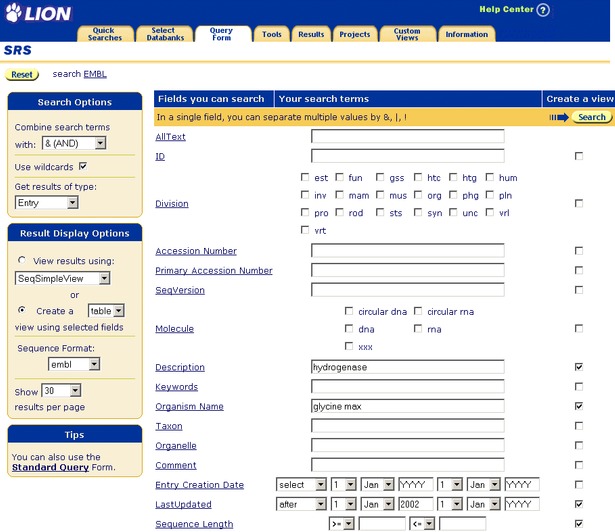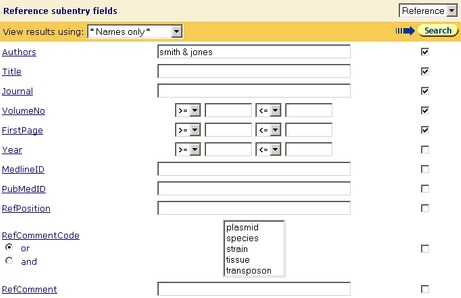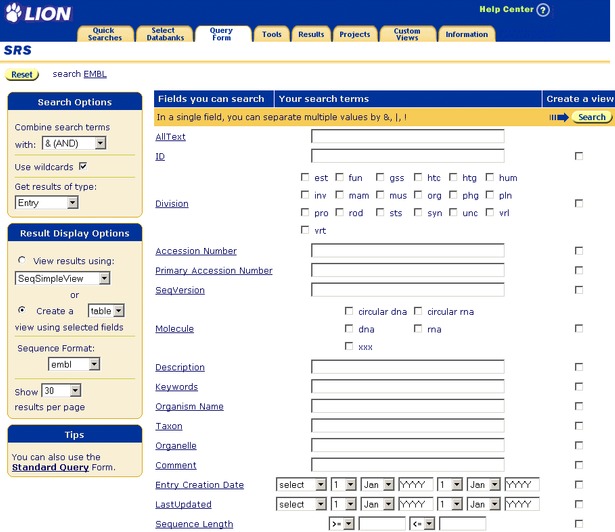Querying - Extended Query Form
Extended Query Form
| Create a query | How do I search for more than one term? | |
| Create a subentry query | How do I search for a phrase? | |
| How do I control how my search terms are combined? |
More about the Extended Query Form.
Extended Query Form - Tasks
Create a Query
Before using the query form you must already have selected the databanks you want to search.
- Type your search terms in the text boxes beside the fields you want to search. Use as many (or as few) search fields as you want.
- Turn Use wildcards off if preferred.
- Set combine search terms with to the appropriate value.
- Specify the Number of entries to display per page.
- Choose a view using the View results using drop-down list. (See chapter 5, "Views", for information on defining a view.) Alternatively design your own view by ticking the boxes beside various fields. (Remember to choose whether you want a table or a list using the drop-down list.)
- Choose a sequence format to be used for any sequences shown in your results, using the sequence format drop-down list.
- Set Get results of type to the required type. This is particularly useful for subentry searches.
- Click the
 button. Your results will be displayed using the selected view.
button. Your results will be displayed using the selected view.
Note:You can search many different data fields at a time using this form. You can also use Boolean operators (&, |, !) within a single field for more advanced searches.
Tip:To find out more information about a data field, click its hyperlink.
Tip:To use subentries in your search, choose one or more datafields of subentry type.
Extended Query Form - Worked Examples
Create a Query
This example demonstrates a search of the EMBL databank for entries having hydrogenase in the description field and Glycine max in the organism field that have been updated since Jan 1st 2002. They will be viewed using the default view.
If you have not already done so, go to the Select Databanks To Search page (Select Databanks tab) and select the databank you want to search.
- In the Description field text box enter the word hydrogenase.
- Type Glycine max in the text box beside Organism. (SRS queries are case insensitive so it does not matter whether you use upper case, lower case or a mixture of the two.)
- In the LastUpdated field change the first (left hand) drop-down list to after. Make sure the next two lists are set to and Jan, respectively. Finally, type into the fourth (year) box. Leave the other boxes alone unless you also want to set a date before which the entries were last updated, etc.
- Define the fields that will be used to display the results by ticking the boxes beside the following fields:DescriptionOrganism NameLast UpdatedSequence LengthIt does not matter whether you search on those fields; you can display any combination of fields you search and fields you do not search.
- Ensure that combine search terms with is set to & (AND).
- Click the
 button. Your results will be displayed using the selected view.
button. Your results will be displayed using the selected view.

Figure 3.1 Extended Query Form showing a query of EMBL for entries with the word, hydrogenase, in the description field that refer to the organism, Glycine max (soybean) and that were added to the databank after January 1, 2002.
Create a Subentry Query Using the Extended Query Form
Searching for Subentries which Reference Papers that are Co-authored by Smith & Jones
Note:Some types of subentry search are not possible from the Extended Query Form, e.g. it does not allow you to search the same field using two separate text boxes as you can using the Standard Query Form. You may also find it useful to look at the examples of how to use subentries on the Standard Query Form.
If you have not already done so, go to the Select Databanks To Search page, select a databank to search, e.g. SWISS-PROT.
- Scroll down the Extended Query Form until you find the section marked, fields of subentry: Reference. Enter smith & jones into the Authors text box.
- Set the Year fields to > .

Figure 3.2 Part of the Extended Query Form showing a query for subentries, using the Reference:Authors fields.
- Choose whether you wish to retrieve entire entries, or the Reference subentries. Choosing Entry will retrieve the parent entries, were Reference will retrieve information for each reference subentry field separately. As there may be more than one Reference subentry that matches your search, retrieving the references may result in information from the same entry being displayed more than once.

Figure 3.3 Choosing whether to retrieve entire entries or the Reference subentries.
- Submit the query as usual.
Extended Query Form - FAQs
Search for More Than One Term
If you want to search for more than one term using different fields, simply use each of the appropriate text boxes on the form and enter your search terms beside them.
Alternatively, if you want to search for more than one thing within any particular field, you can use the boolean operators (&, |, !) to combine two or more entries within a given text box. This is particularly useful for subentries.
Search for a Phrase
Enter your phrase within a single text box.
How Do I Define How My Search Terms are Combined?
Use the Boolean operators in the Combine search terms with drop-down list to combine terms in separate rows.
Alternatively, type them into the text boxes between your search terms. The available operators are:
| & | AND | phosphorylase & methyltransferase |
| | | OR | rat | mouse |
| ! | BUTNOT | nitrogenase ! reductase |
Multiple terms can be combined using brackets, e.g. to search for entries whose Organism Name field contains rat or mouse, but not bovine, you could type:
(rat | mouse) ! bovine
Extended Query Form - Reference

Figure 3.4 Extended Query Form.
Getting to the Extended Query Form
This page can be reached by any of the following methods:
-
Clicking the
 button on the Select Databanks To Search page.
button on the Select Databanks To Search page. - Clicking the Extended Query Form link on a Standard Query Form page.
- Clicking on the Query tab if you have set your default Query Form to be the Extended Query Form.
Using the Extended Query Form - Options Area
Search

This shows a list of the databanks that will be searched when the query is submitted. The databanks to be searched are selected from the Select Databanks To Search page.
Submit Query
When you have defined your query, click the  button.
button.
Use Wildcards
By default this box is ticked and wildcards are appended to all search words automatically. If wildcards are not to be appended, untick the check box.
Combine Search Terms With
The query terms will have a relationship with each other that is either inclusive or exclusive. Using the drop-down list you can choose the way your search terms are combined.
- & (AND)
- All the query terms must be present for an entry to be included in the results of the query. This is the default.|
- | (OR)
- If any of the terms are present in an entry it will be included in the results.
- ! (BUTNOT)
- The first term must be present but the other terms must be absent from the entry for it to be included in the results.
Number of Entries to Display per Page
This drop-down list allows you to specify the maximum number of entries to be listed per page of results. When the number of entries is greater than this value, entries will be spread over two or more pages.
Standard
The Standard Query Form link takes you to the Standard Query Form to continue your query without having to reselect the databank(s).
Make Default Query Page
This option can be ticked to make the Extended Query Form into the default used for queries. Making this the default Query Form means that if you click on the Query tab, the Extended Query Form is used, rather than the Standard Query Form. You will need to submit a query, etc., for this to take effect.
Using the Extended Query Form - Data Area
Use View
A predefined view can be used to display the results of a search. This is chosen using the drop-down list, which contains the built-in views, and any views created during the current project. (See also View Manager page 1 and View Manager page 2.)
Sequence Format
You can choose the sequence format with which to display the results from the drop-down list.
Submit Query
When you have defined your query, click the  button.
button.
Field Name
The left-hand side of the Data Area contains a list of datafields that can be searched. You can choose the datafield(s) you wish to search simply by entering text in the text box beside any datafield(s) you wish to search.
The names are also hyperlinks to the Field Information page for each datafield.
Query
Enter the search term in the text box to the right of each datafield you wish to search. You may search for more than one term in each text box, using the operators, & (AND), | (OR) and ! (BUTNOT), to indicate how the terms should be related. Any text box left empty will be ignored in the search.
Create View
Tick the check box beside any datafield(s) you want to include on the Query Result page. It is not necessary for a query to be made against a datafield for it to be included in the results page.
The drop-down list allows you to choose whether the results are displayed using a table or list view.

Submit Query
When you have defined your query, click one of the  buttons. This button appears several times on this page; all perform the same task.
buttons. This button appears several times on this page; all perform the same task.
Fields of Subentry:
These headings tell you what types of subentry are available. Typical fields include reference, comment, feature and counter. Any of these can be searched. See also "Subentries" in chapter 3, "Querying with SRS", of the SRS User Guide
Retrieve
This option relates to the fields of subentry. It allows you to choose whether to retrieve the complete entry, or just the subentries. See also "Subentries" in chapter 3, "Querying with SRS", of the SRS User Guide
Other Information
